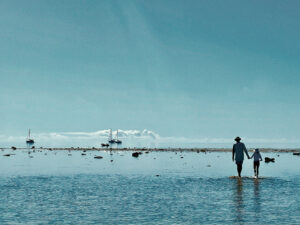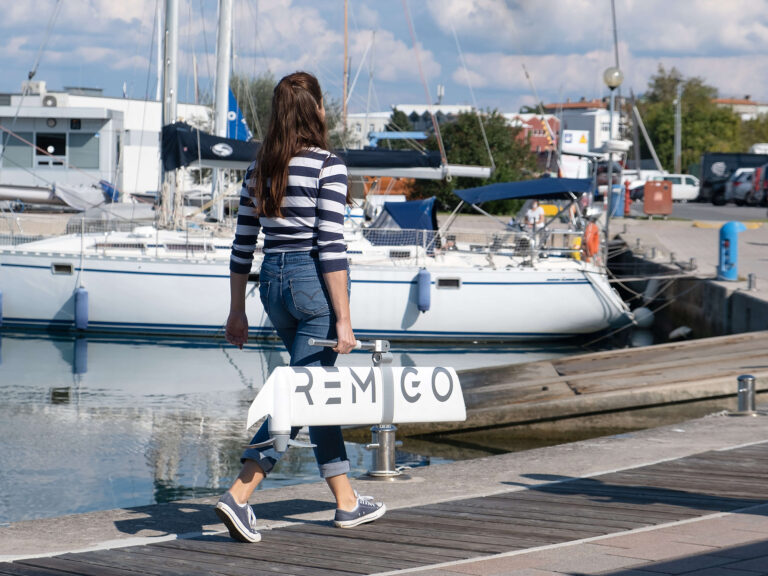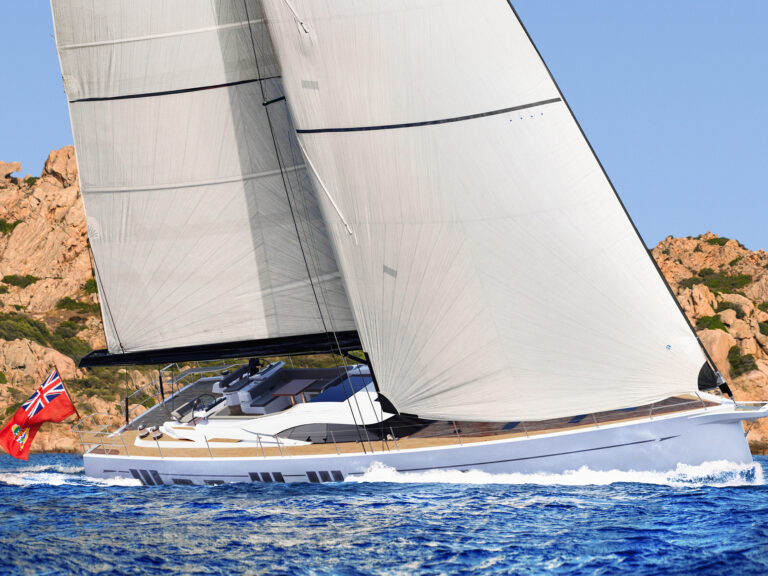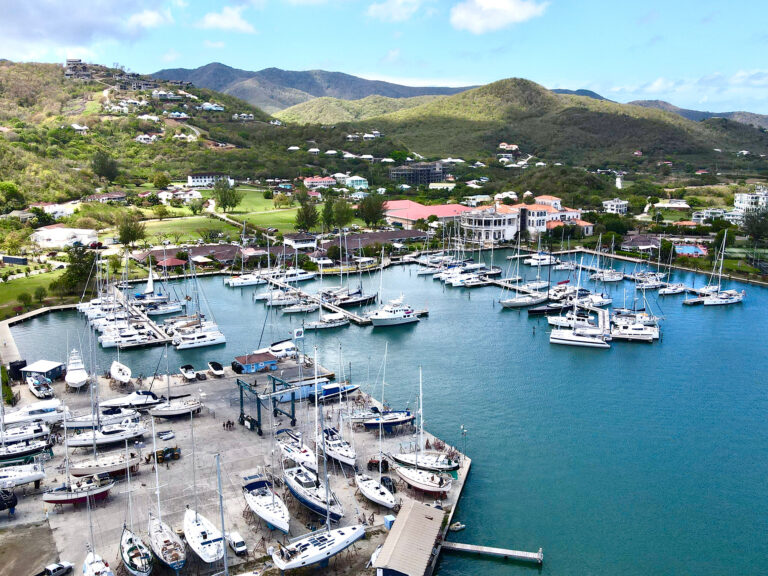“Mentally I was fully prepared to kill all three of them,'” said Carel from the 37-foot cruising boat Obsession.
Local thieves had made the error of picking on Obsession, anchored in a secluded cove in the Golfete known as Gringo Bay, about four miles from where Ithaka is right now. Carel and his wife Bea were aboard, as well as Bea’s elderly parents, who were visiting from Switzerland. At about sundown, Carel heard a knock on the side of the hull. He hopped into the cockpit to find three guys in a cayuco asking for gasoline. The policy on Obsession is that no one is allowed on board without an invitation, but two of them started to climb on. Carel tried to dissuade them with words, when one man grabbed his arm, and he saw a gun in the hands of the second. Bea could hear that there was a problem. She took the pepper spray, which was near the companionway, reached her arm out and, unsure of how to use it, began spraying a wide arc in the direction of the voices. She hit the two boarders, one of whom twice fired his nine-millimeter gun into air, before both fell back into the cayuco and fled. “I got a good dose, too,” said Carel. Bea’s parents, eating dinner at table, didn’t know anything was wrong until they heard the shots.
| | Bea and Carel * * *| Carel van Heerten, 36, spent years in the South African military; hes an instructor in hand-to-hand combat, martial arts, and has trained special forces from around the world. That night, he decided to offer a seminar on yacht preparedness and personal defense, and announced it on the net a few days later. More than 40 cruisers altered whatever plans they had, met at Mangos Marina on Saturday at 2 pm, and stayed until nearly 6 pm, talking, listening, and practicing techniques.
“I grew up on a farm in a terrorist area of South Africa. I had to learn to think like a bandit,” said Carel. “But I was not suspicious enough that night. I was in cruising mode, and I didnt suspect trouble until I saw the 9-mm come out. Although it felt like three weeks, the whole incident took maybe 15 seconds. There was no opportunity to think.
“Well have no discussion of firearms today,” continued Carel. “Theyre illegal in Guatemala, and theyre too dangerous. Also, you run the risk that someone more skilled and less conscionable than you can capture your gun if you hesitate to use it ruthlessly. Its difficult to shoot someone dead without training or good luck. Its almost impossible to shoot someone whos holding your child or wife with a knife.”
First Line Of Defense: Mental Attitude
“If youre the kind of person who cant do damage to another person, youre wasting your time here. If youre not prepared to kill a person, youre likely to die in a confrontation. What we used to say in the dojo is: Its better to be tried by 12, than carried by six.” Carel almost lost me at this point, and I noticed a few other people in the group also getting a bit uneasy.
“After dark, our standard operating procedure on Obsession is that if someone approaches, or if there’s noise, Bea stays below and I go outside to check it out. First, keep people off your boat. Second, keep them out of the cockpit. Third, keep them from coming below, where it’s much harder to get rid of them. If somehow I’m compromised, shot, or stabbed, Bea is to go to the V-berth, slip through the hatch, go quietly over the side, and get away. We don’t want two people dead. She can hold onto the anchor rode and can duck on either side of the boat to escape. Then I don’t have to worry about her as a hostage. I can concentrate on what I have to do.
| | A strong light in the eyes ruins night vision. * * *| “Your second line of defense is pepper spray. We keep it right at the companionway, and also forward in the V-berth. Pepper spray (mace) wont kill anyone, but itll re-establish your dominance and buy you time to get away. Dont be afraid to run. Ive won more fights by 50 yards than with my fists. If you cant get away, theres plenty of equipment on your boat that can be used as defensive weapons. Your fire extinguisher can blind someone pretty well. So can wasp spray, which has a trajectory of more than 10 feet. Ice picks, winch handles, spear guns, galley hardware, machetes, fids, pencils, knitting needlestheyll all work. A four-inch knife is lethal, but remember, never, _ever_ show your weapon before youre ready to use it aggressively. Surprise is your ally.
“At night, if someone you dont know comes alongside your boat, shine a bright search light right in their eyes. This will ruin their night vision for 10 seconds. Flash it in their eyes every six or eight seconds. If they have evil intent, it helps to disarm them. If not, no harm done.”
“If the man trying to board Obsession had gotten into cockpit, he would not have survived. I had a four-inch knife and a screwdriver nearby. Poor and angry people are dangerous. If someone pulls a gun on you, he’s crossed a line. You must understand at that point that he’s willing to kill you.”
Id always imagined that logic, negotiation, or cooperation, would get me out of a tough situation. But Carel was forcing me to think differently. What would be a situation in which I could act outside my normal level of non-violence? Could I kill someone? I know Id do whatever it took to save my family in a life-threatening situation. But what does that mean? Carel was making it plain that these situations were never clear cut. If someone pulls a gun on you, understand, hes willing to kill. I decided to learn what Carel had to teach me.
The Deterioration of Banditry As An Honorable Profession
There was a time, according to Carel, when bandits left the family at home and plied their trade more or less honorably. “But now they enlist women and children as decoys in distress, and wave down boats, and rob them. Look at Nam, where women and children were couriers, and armed. Everything changed. Being a good Samaritan is dangerous,” he warned. “Dont be a fool.”
| | Singlehanded circumnavigator Joshua Slocum sprinkled tacks on his decks at night to dissuade boarders. Brian and Christine King on Mustang do the same with these ingenious mats of tack nails. * * *| Flare Guns
Many people keep an extra flare gun near the companionway to use for self defense. Carel was skeptical. “Only shoot a flare gun at other boats, not at someone on your boat. This is basically a phosphor-propelled rocket tube, and you could easily set fire to your boat, not to mention the danger it poses to your propane tanks, which could explode. If you shoot a regular plastic flare gun at someone at 10 feet, itll bounce off them and not even knock them off the dock.” Someone asked about using a shot shell in the flare gun. “Bad,” said Carel. “The plastic gun melts down to the handle when a shot-gun shell is used. A steel flare guns a different story, but it needs a special insert sleeve. At close range, that could take a person out, but I wouldnt have one on my boat. Too dangerous.”
Protection and Alarm Systems
One fellow at the seminar said he had trip-wire alarm system; one had an infra-red motion sensor; one a relay siren, like the kind you put on hotel doors; one had installed an electric fence used to train dogs (“Low power consumption,” he said, “and it makes people yelp with surprise. They wont grab my lifelines twice. But Im having a problem grounding it. When its on, it interferes with the electronics.”) The most elaborate system we heard about was by a company named Shureck, who installs custom pressure transducers under the deck. Step in the general area of a transducer, and an alarm is set off. Carel knew of a yacht that had one; when it was activated, a deep voice bellowed: “YOU ARE NOT AUTHORIZED TO BE ON DECK!” Great, I thought, for your bilingual pirate. One fellow said the moths were so large off the west coast of Costa Rica that they kept setting off his motion alarm. Another guy installed an alarm system with buzzer, sirens, and lights. Douglas and I caught each others eye. Wow. We pretty much leave everything open at night, and go to bed. “Maybe,” Douglas leaned over and whispered, “we should mount a Gatling gun on the foredeck.”
| | “We keep a stun gun mounted near the companionway,” said Brian, “and bear spray. If it can dissuade a grizzly, it ought to work on a bandito…”* * *| Physical Training Techniques
What happened next was sobering. Carel taught us a series of physical techniques designed to get ourselves out of tough situationssomeone grabbing around the neck, putting a pistol to the head, attempting rape. Each response technique was based on circular motions, Akido, and using the weight and force of the other person violently against him. “Just remember, you need 100 percent commitment if youre going to fight,” said Carel. We divided ourselves into pairs. He slowly demonstrated with Bea ways to break a trigger finger, a wrist, an elbow, the neck, and the nose. “You can easily break the short ribs and sternum with your knee, which causes excruciating pain; but my preference is the neck. Death is within four seconds. Im very aggressive,” he said. “Ill go all the way. Its not about strength; a girl could do it easily. If someones on drugs, a kick to the groin is totally useless. He wont feel pain, and itll just make him mad.”
| | Carel, left, demonstrates a self-defense technique with one of the cruisers at the seminar 6) Christine King holds the homemade fluorescent 12-V cockpit light they hang in Mustangs cockpit; it draws less than an amp. The Kings also have switches for all their deck lights and horns mounted over their bunk, within reach if theyre disturbed during the night. * * *| Crime In The Caribbean – Comments From Other Cruisers At The Seminar
“In Venezuela last year, a guy on the boat next to ours was shot in the face by robbers. We ended up taking care of their kids for a week while they went to the hospital…”
“We keep a machete near the companionway. If anyone comes down those steps, Ill cut the bastards toes off…”
“In the Leewards last winter, a cayuco motored up to us, and two men tried to board us. We sped up, they gained on us, so we cut hard toward them. The wake turned them over and we got away…”
“We were making a passage in the Bahamas one night and noticed on the radar that we were being followed. The other boat closed in on us, but wouldnt answer on the radio. We called the Coast Guard, gave them our position, and they said they were sending a plane and a boat out. The boat following us fell back. We stayed on the radio for an hour, which is how long it took for this boat to turn away. The Coast Guard never showed up.”
| | Christine King holds the homemade fluorescent 12-V cockpit light they hang in Mustangs cockpit; it draws less than an amp. The Kings also have switches for all their deck lights and horns mounted over their bunk, within reach if theyre disturbed during the night. * * *| “If that happened to us, wed use our hand-held VHF and our ships VHF, and bluff. Id speak into one, my wife into the other, and wed talk to each other as if we were two boats traveling together. Id tell my buddy boat whats happening. My buddy would say shes standing by under a mile away, that she has no lights on, that shes closing in, and wed talk about all the weapons we all have…”
“If I can hit a hogfish on the run under water, I ought to be able to put a spear thru the head of a pirate…”
“If were anchored with another boat, even if we dont know them, well check in, and establish a VHF frequency to monitor. When we travel with a buddy boat, we decide on an air horn signal to indicate distress…”
“Along the Venezuelan coast, we locked ourselves into the boat every night. Finally we had one-inch stainless steel tubing installed as bars across our hatches…”
“If you chose not to go to every country youre warned against, you might not get out of the Great Lakes. We wouldnt visit the Seychelles right now, or Indonesia, or Yemen, but overall wed go most anywhere. In the Rio, most people anchor in groups, or stay in the marinas, where its cheap and completely safe…”
“If we sense trouble, we put our miniature schnauzer on deck and tell him to bark his heart out…”
| | Christine and Brian made this very visible dinghy light out of strobe lights clipped to a stick; they say it looks like police lights at night. (The lights are the ones some joggers clip to their clothing.) * * *| “Never announce on any local net your intentions to leave a place. That just tells people youre well stocked, have money and will soon be alone. Say your goodbyes in private. Robbers have radios too…”
“When we anchor, wherever we are, as it gets dark we scan a search light around, and blow our horn. This lets people know were capable of making a lot of noise. We distribute our assets throughout the boat, but always have cash on hand near the cockpit…”
“Three nights ago, around 11, a cayuco came up to my boat. I ran out into the cockpit, and these guys tell me theyve run out of gas, and the Texaco is closed. I gave them some gas. The next morning there were three fresh fish on my deck…”
“Lucky those guys didnt go to Carels boat,” I whispered to Douglas.
We headed back to Ithaka at dusk, our heads filled with disturbing images, our conversation filled with ideas on what we should do to be more prepared. A sailboat appears as a multimillion dollar temptation to poor people who have no jobs, who are between wars, who still have guns, and no viable means of making a living. Thanks to Carel, Douglas and I are a little less naive today than we were yesterday. As our dinghy sliced through the placid river, we watched the sunset turn the sky and mountains pink, orange and purple. “What a beautiful place,” I thought.








